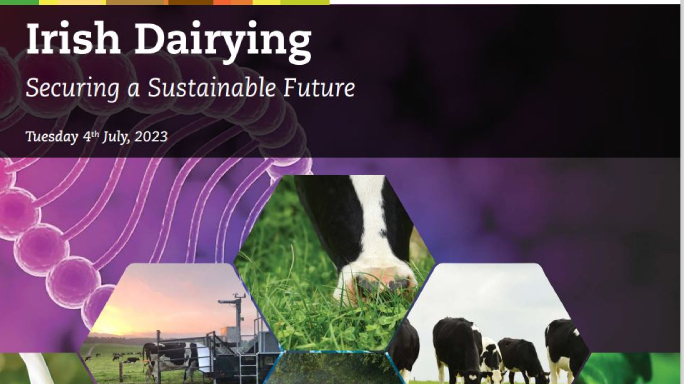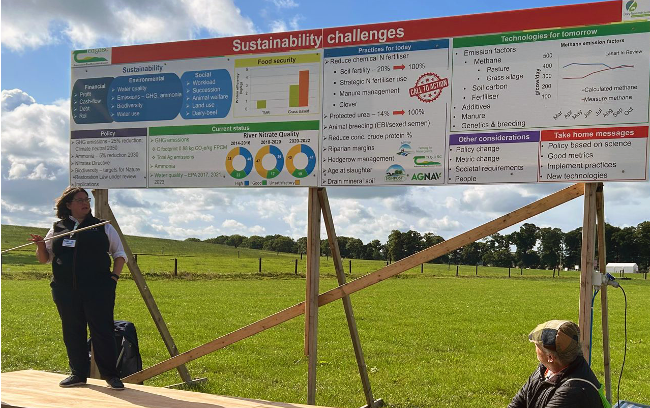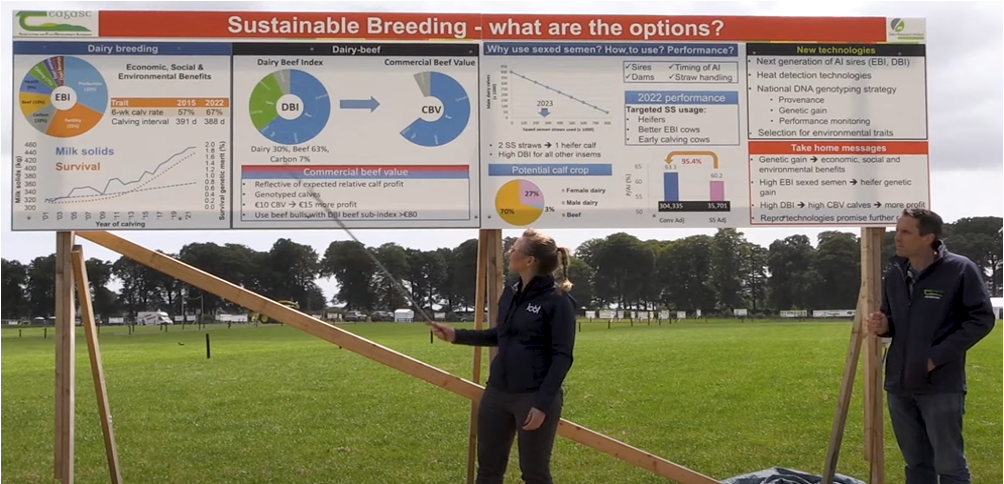Moorepark Open Day 2023 Recap

The Moorepark Open Day 2023 was a highly anticipated event for farmers and industry professionals in the agricultural sector. The theme of the open day was “Securing a Sustainable Future”.
During the event, the Minister for Agriculture Charlie McConalogue highlighted the importance of sustainability in the dairy industry. He emphasised the need for farmers to adopt sustainable practices that not only benefit the environment but also contribute to the long-term success of their farms. This set the tone for the rest of the day, with a focus on sustainable farming methods and their impact on the industry.
One of the key topics discussed at the open day was the importance of soil health and the role of soil in sustainable farming. It was mentioned that farmers need to pay attention to soil health and use practices that promote soil fertility, such as liming to improve soil pH and optimise soil P and K levels. This not only helps to maintain soil health but also leads to better yields and leads to increased N use efficiency and opportunities to save chemical N fertiliser inputs on farms.
Another important topic was the use of technology in the dairy industry. Farmers were introduced to the latest technological advancements that can aid in sustainable farming. This includes tools like LESS, animal breeding, soil analysis technologies, the latest fertiliser technology and others on the day which can help farmers make informed decisions about their farming practices. It was also noted that technology can help reduce waste and improve efficiency, contributing to a more sustainable future for the industry.
The issue of animal welfare was also addressed at the open day. A panel of experts discussed the importance of providing a high standard of care for dairy cows. This not only benefits the cows' well-being but also leads to better milk yields and quality. Farmers were reminded of their responsibility to ensure the welfare of their animals and were encouraged to adopt best practices for animal care.
One of the key take-home messages for farmers was the importance of sustainability in securing the future of Irish dairying. The speakers stressed that sustainability is not just about environmental conservation but also about creating a profitable and resilient farming system. By adopting sustainable practices, farmers can reduce costs, increase efficiency, and improve the quality of their products. This, in turn, will help to maintain the competitiveness of the Irish dairy industry in the global market.
The four key storyboards at the start of the open day:
The Sustainability Challenges
Link to the research: Sustainability Challenges
The speakers Laurence Shalloo and Deirdre Hennessy discuss the sustainability challenges facing farmers, focusing on financial, environmental, and social pillars. They compare farming systems, highlight the need to reduce emissions and improve water quality and emphasise the importance of reducing chemical nitrogen fertiliser and increasing soil fertility on dairy farms. The carbon footprint of Irish milk was outlined to be one of the lowest over the period from 2017 -2019. The average dairy carbon footprint with carbon sequestration included was 0.86kg CO2e/kg of fat and protein corrected milk (FPCM). According to Teagasc on the day the 2022 analysis so far suggests on that carbon footprint of Irish milk production could be close to 0.61kg CO2e/kg FPCM, showing a significant reduction in Irish dairy emissions as more sustainably practices are being introduced on farms. However, the focus was to remind farmers the importance of water quality. The role of white clover in replacing chemical fertiliser nitrogen is emphasised, along with the importance of protected urea, animal breeding, and reducing crude protein concentrates to minimise nitrogen losses. Additionally, the significance of riparian margins and hydro management in addressing biodiversity and reducing nitrogen loss to waterways was highlighted. The speakers concluded by emphasising the need for farmers to take responsibility for achieving climate and emission targets, implementing available technologies, and being prepared to adapt to policy changes and societal requirements. The speakers concluded with the importance of farmer adoption of measures such as LESS, soil fertility management, reduction in crude protein in concentrates, hedgerow management, reduction of N fertiliser use, and more to help improve water quality and reduce emissions of farms.

Figure 1 Deirdre Hennessy at Moorepark 2023
Profitable Systems
Link to the research: Dairy systems – Farming Today with Tomorrow in Mind
Padraig French discusses the evolution of the dairy industry, focusing on key performance indicators and technologies that have driven profitability over the last 10 years. He notes significant progress in areas such as six-week calving rate, age of herd, and tons of grass utilised per hectare, but expresses concern about the percentage of grass in the diet. He also addressed the impact of milk prices and costs on profitability, advising farmers to budget and forecast their finances. Additionally, he discussed the increase in stocking rates on farms and the need to assess stock for the upcoming winter. Conor Hogan followed up by emphasising the importance of maintaining a pasture-based system and the economic and social aspects of dairy farming. Conor highlighted the need to focus on key performance indicators such as stocking rate and budgeting, as well as the importance of labour efficiency and work organisation. The potential for increased profitability through labour efficiency was also emphasised, with farmers encouraged to aim for a 50-hour work week in spring.

Breeding and Reproduction
Link to the research: Sustainable and Responsible Breeding and Reproductive Programs
Siobhan Ring from the Irish Cattle Breeding Federation and Stephen Butler from Moorepark discussed sustainable breeding options, focusing on productivity, health, and environmental impact. They introduced updates to breeding from TB resistance, economic values, and carbon sub-index to make the breeding goal more sustainable. Improvements in fertility and milk solids have been seen, and a tool called the Dairy Beef Index (DBI) has been developed to generate good beef bulls for dairy herds. They also discussed the use of sexed semen to decrease the number of male dairy calves and replace them with beef cross animals. Siobhan mentioned that when selecting beef sires using the DBI to look for a beef sub-index higher than €80 for Friesian cows and €100 for Jersey genetics. Between 250,000 and 300,000 sex semen straws were available for use in 2023, which is about one-third of the way to the goal of 800,000. It was recommended to use two-sex semen straws for every heifer calf you want to produce. Using a large team of bulls minimises the chance of fertility drops. The timing of AI is critical, targeting 14 to 20 hours after heat onset. Performance data showed that sex-sorted semen has a pregnancy rate of 60%, similar to conventional semen. New technologies such as IVF embryos and heat detection technologies are being used to accelerate genetic gain. The take-home message was to use high EBI sex semen and high DBI beef semen to accelerate genetic gain and contribute to the genetic merit of the national herd. Benchmarking the genetic merit of the national average herd is an important factor to consider when evaluating the overall quality and productivity of your herd. It is crucial to continuously assess and improve the genetic merit of your herd to ensure long- term success and sustainability.

Figure 2 Siobhan Ring and Stephen Butler at Moorepark 2023
Sustainable Grassland Production
Link to the research: Grassland the Source of a Sustainable Future
Michael O’Donovan and Michael Egan discuss the potential for grass growth on farms and the importance of productive farms leading to profitable farms. They have found that grass clover and perennial ryegrass swards are the most cost-competitive and can lead to increased dry matter production. They emphasise the importance of grazing management and hitting grazing management targets to ensure the farm is growing enough grass to feed the herd. Optimising nitrogen levels and clover usage to reduce the need for chemical nitrogen on the farm is also highlighted.
Michael Egan breaks down the management into spring, summer, and autumn, highlighting the need to increase grass growth and nitrogen uptake, as well as the role of clover in the system. He emphasises the importance of slurry application in spring, matching grass growth rates with demand in summer, and increasing rotation length in autumn. The need to increase clover content on farms and reduce chemical fertiliser is also discussed, with data from the Clover 150 project showing positive results in terms of reducing nitrogen fertiliser and maintaining overall herbage production. Increasing sward clover content to >20% will allow herbage production to be maintained on farms, allowing chemical N fertiliser to be reduced. The major focus for dairy farms in the next two to three years will be to increase the clover content in swards (through reseeding and over-sowing), but also improve soil fertility and grazing management practises.
Michael O’Donovan outlines grassland performance targets, including maintaining herbage production and accurately stocking farms. It emphasises the importance of accurately stocking farms to avoid overstocking or understocking, and the need for a huge improvement in soil fertility to achieve high grass growth levels. He outlines the need to maintain herbal production between 14 -15 t DM/ha per year while using more precision management with N fertiliser applications while looking at milking platform stocking rates. The key takeaway is the importance of aligning stocking rates with grass growth patterns and incorporating clover into farming systems to reduce chemical nitrogen inputs.

The Moorepark Open Day 2023 was a great success, with over 5,000 attendees. The event provided a platform for farmers to learn from experts, share their experiences, and network with other industry professionals. It also served as a reminder of the crucial role that farmers play in securing a sustainable future for Irish dairying.
In conclusion, the Moorepark Open Day 2023 was a significant event for the Irish dairy industry. It highlighted the importance of sustainability in securing the industry's future and provided farmers with valuable insights on how to achieve this goal. As we move towards a more environmentally conscious future, it is essential for farmers to continue to adopt sustainable practices and work together to ensure the long-term success of the Irish dairy industry.
Sustainability Action Payment
Tirlán has committed to assist our dairy suppliers in reducing the carbon footprint, enhancing water quality and improving air quality and soil health of farms in line with our sustainability strategy, Living Proof and Sustainability Action Payment.

First Published 15 April 2024
Tagged with: Dairy
